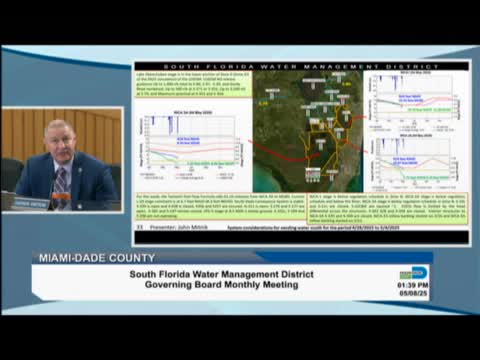Water Management District outlines drought responses for Miami Dade and Broward counties
May 08, 2025 | Miami-Dade County, Florida
This article was created by AI summarizing key points discussed. AI makes mistakes, so for full details and context, please refer to the video of the full meeting. Please report any errors so we can fix them. Report an error »

The Miami-Dade County - South Florida Water Management District Governing Board convened on May 8, 2025, to discuss critical water management issues affecting the region. The meeting focused on the current water supply conditions across various conservation areas, the impact of recent weather patterns, and ongoing projects aimed at improving water quality and ecosystem health.
The meeting began with an overview of water levels in Conservation Area 1, which are slightly below the regulation schedule but remain stable due to low water supply demands. In contrast, Conservation Area 2, which serves Broward County, is significantly below its floor elevation. To address this, the board initiated a water banking strategy to manage supply deliveries and prevent saltwater intrusion into the groundwater.
Discussion then shifted to Conservation Area 3, which serves Miami-Dade County. Similar to Area 2, it is also below its floor elevation but continues to receive inflows from the north. Water supply deliveries to Miami-Dade are ongoing, with efforts to maintain canal levels and support Everglades National Park.
The board highlighted the importance of recent rainfall, which has helped stabilize canal levels and improve conditions for wading birds in the region. However, the overall water supply situation remains precarious, with some areas experiencing drought conditions. The board noted that approximately 20% of bird nests have failed due to dry conditions, emphasizing the need for continued rainfall to support wildlife and ecosystem health.
The meeting also addressed the Biscayne Bay Coastal Wetlands Project, which aims to rehydrate coastal marshes and monitor salinity levels. Positive trends were reported, including improved vegetation and the return of certain species to the area.
Looking ahead, the board expressed cautious optimism regarding the upcoming wet season, with predictions of above-average rainfall. However, concerns remain about potential drought conditions in the following dry season, influenced by climate patterns such as La Niña.
In conclusion, the meeting underscored the ongoing challenges of water management in South Florida, particularly in light of changing weather patterns and ecological needs. The board remains committed to proactive measures to ensure sustainable water resources for the region.
The meeting began with an overview of water levels in Conservation Area 1, which are slightly below the regulation schedule but remain stable due to low water supply demands. In contrast, Conservation Area 2, which serves Broward County, is significantly below its floor elevation. To address this, the board initiated a water banking strategy to manage supply deliveries and prevent saltwater intrusion into the groundwater.
Discussion then shifted to Conservation Area 3, which serves Miami-Dade County. Similar to Area 2, it is also below its floor elevation but continues to receive inflows from the north. Water supply deliveries to Miami-Dade are ongoing, with efforts to maintain canal levels and support Everglades National Park.
The board highlighted the importance of recent rainfall, which has helped stabilize canal levels and improve conditions for wading birds in the region. However, the overall water supply situation remains precarious, with some areas experiencing drought conditions. The board noted that approximately 20% of bird nests have failed due to dry conditions, emphasizing the need for continued rainfall to support wildlife and ecosystem health.
The meeting also addressed the Biscayne Bay Coastal Wetlands Project, which aims to rehydrate coastal marshes and monitor salinity levels. Positive trends were reported, including improved vegetation and the return of certain species to the area.
Looking ahead, the board expressed cautious optimism regarding the upcoming wet season, with predictions of above-average rainfall. However, concerns remain about potential drought conditions in the following dry season, influenced by climate patterns such as La Niña.
In conclusion, the meeting underscored the ongoing challenges of water management in South Florida, particularly in light of changing weather patterns and ecological needs. The board remains committed to proactive measures to ensure sustainable water resources for the region.
View full meeting
This article is based on a recent meeting—watch the full video and explore the complete transcript for deeper insights into the discussion.
View full meeting